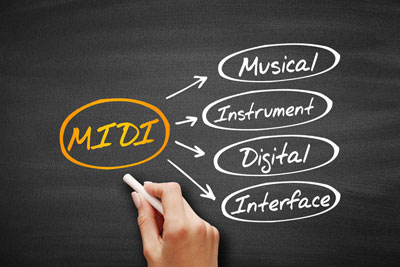MONO, POLY and OMNI ON/OFF
Welcome back, my friends. Are you ready to begin? Heh, heh... sort of sounds like the dentist, doesn't it? Hopefully, this column is a LITTLE easier to take than that! I dunno, though. Some of the calls and letters I'm getting sound like maybe I'm giving some of you headaches... Oh, by the way: I finally got my R-8 (drum box) expander card from Roland -- heh.
 This month we dig deeply into the complexities of what first appears patently simple - MONO, POLY, OMNI ON/OFF interactions. As you may recall, OMNI mode is used to cause a receiving instrument to respond to ALL channel messages. Consider how important this can be: IF you make an error, and turn on OMNI when you are sending multiple channels down your line, your poor instrument will try to play all the parts at once. This is rather like trying to listen to all bands of radio frequencies at once. It only works if there is only one station transmitting! If, on the other hand, OMNI is accidentally turned off when you were depending on it, you might get no sound at all, depending on which channel you were receiving, and which was being sent. The basic principle once again is, if OMNI is on, the receiving instrument will respond to ALL channels. If OMNI is off, the receiver will respond only to its assigned channel.
This month we dig deeply into the complexities of what first appears patently simple - MONO, POLY, OMNI ON/OFF interactions. As you may recall, OMNI mode is used to cause a receiving instrument to respond to ALL channel messages. Consider how important this can be: IF you make an error, and turn on OMNI when you are sending multiple channels down your line, your poor instrument will try to play all the parts at once. This is rather like trying to listen to all bands of radio frequencies at once. It only works if there is only one station transmitting! If, on the other hand, OMNI is accidentally turned off when you were depending on it, you might get no sound at all, depending on which channel you were receiving, and which was being sent. The basic principle once again is, if OMNI is on, the receiving instrument will respond to ALL channels. If OMNI is off, the receiver will respond only to its assigned channel.
What about the transmitter? What does OMNI do for the transmitting instrument? The answer is "nothing" most of the time. The last part is the clincher. You see OMNI mode is easy to understand when you consider it only as it applies to polyphonic instruments in polyphonic mode. POLY and MONO modes can be downright confusing at times though.
Let's first define what we are NOT talking about. We are not talking about "multi-timbral" abilities. Recall that a multi-timbral instrument has the ability to play not only many notes, but many voices on separate channels. For instance, you may assign the new Roland U-220 to deliver piano when messages arrive on channel #1, but strings when messages arrive on channel #2. As with all truly multi-timbral instruments, the U-220 can handle both at the same time. Since purely MONO instruments are so rare nowadays, some manufacturers have started to refer to multitimbral capability as POLY mode. This doesn't help anyone though. I think Ensoniq has the answer when they call this "multi" mode. POLY and MONO modes are clearly defined by the MIDI creators to mean polyphonic and monophonic.
Fancy words like "monophonic" deserve to be explained. No, it's not the same thing as "monaural," which was what we listened to before we bought "stereos." "Monophonic" simply means that no matter how many notes you play, only ONE will sound at a time. "Polyphonic" means, the ability to sound more than one note at a time. Again, "multitimbral" is something entirely different.

